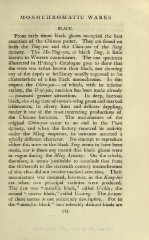Page 397 - Oriental Series Japan and China, Brinkly
P. 397
MONOCHROMATIC WARES
BLACK.
From early times black glazes occupied the best
attention of the Chinese potter. They are found on
both the Ting-yao and the Chien-yao of the Sung
dynasty. The Mo-Ting-yaoy or black Ting, is little
known to Western connoisseurs. The one specimen
illustrated in H'siang's Catalogue goes to show that
the ware was rather brown than black, not showing
any of the depth or brilliancy usually supposed to be
characteristic of a fine black monochrome. In this
respect the Chien-yao of which, with its inferior
variety, the U-ni-yao, mention has been made already
possessed greater attractions. Its deep, lustrous
black, showing tints of raven's-wing green and marked
iridescence, its silvery lines and delicate dappling,
render it one of the most interesting productions of
the Chinese keramist. The manufacture of the
original Chien-yao came to an end in the Tuan
dynasty, and when the factory renewed its activity
under the Ming emperors, its outcome assumed a
wholly different character. No attempt to reproduce
either this ware or the black Ting seems to have been
made, nor is there any record that black glazes were
in vogue during the Ming dynasty. On the whole,
therefore, it seems justifiable to conclude that from
the thirteenth to the sixteenth century monochromes
of this class did not receive marked attention. Their
manufacture was resumed, however, in the Kang-hst
era when two principal varieties were produced.
The first was "metallic black," called U-chin ; the
second " mirror black," called U-ching. The former
of these names is not accurately descriptive. For in
the " metallic black " two tolerably distinct kinds are

